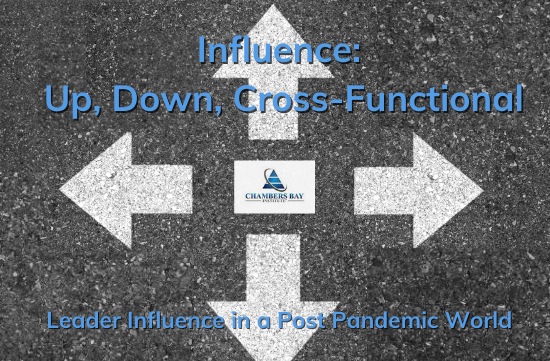Influence: Up, Down, Cross-Functional
Leader Influence in a Post Pandemic World
“The key to successful leadership is influence, not authority.” –Kenneth H. Blanchard
by Jim Solomon and Bruce LaRue, Ph.D.
Integrator Leaders Lead Through Influence
Integrator Leaders create a clear compass heading for their team while helping them develop the map to get from here to there. They understand that they must do so by leading through influence – up, down, cross-functionally – to create alignment behind their organization’s strategic goals. In this way, they forge new bonds for the good of the mission, never for personal gain, to attain the greatest outcomes.
“By definition, influence is the ability to affect the behavior of others in a particular direction, leveraging key tactics that involve, connect, and inspire them.” Center for Creative Influence
With greater demands being placed upon organizations as we move forward through the global pandemic, a leader’s ability to influence becomes even more critical. Today, a leader must be able to influence beyond their team and often must do so working in a virtual environment. Though staying “within your lane” is critical while driving down the highway, learning to influence outside your direct sphere allows leaders, wherever they are within the organization, to have a more significant impact in achieving strategic goals.
Influence Up
Leading up involves influencing your boss and others senior to you through your insight and knowledge for the betterment of the organization.
When influencing up, learn to see through the lens of your boss. Influencing up begins with your ability to teach. Sharing information or knowledge must be presented in a manner that will benefit the organization, never generating defense or resistance. Turn the spotlight from you and shine it on the organization and its strategic goals. Share how your ideas will benefit the organization today and in the future, as well as how they will meet your customer’s needs. Always make feedback constructive and presented in a receptive manner.
Marshall Goldsmith, acclaimed executive coach, author, and speaker, in his article “Effectively Influencing Up: Ensuring That Your Knowledge Makes a Difference”, provides useful tips for leaders to put to practice. Here are three of Marshal’s key principles:
- When presenting ideas to upper management, realize that it is your responsibility to sell – not their responsibility to buy.
In many ways, influencing up is similar to selling products or services to external customers. They don’t have to buy – you have to sell! Any good salesperson takes responsibility for achieving results. No one is impressed with salespeople who blame their customers for not buying their products. While the importance of taking responsibility may seem obvious in external sales, an amazing number of people in large corporations spend countless hours in “blaming” management for not buying their ideas. If more time were spent on developing our ability to present ideas, and less time were spent on blaming management for not buying our ideas, a lot more might get accomplished. The effective upward influencer needs to be a good teacher. Good teachers realize that communicating knowledge is often a greater challenge than possessing knowledge.
- Focus on contribution to the larger good – not just the achievement of your objectives.
An effective salesperson would never say to a customer, “You need to buy this product, because if you don’t, I won’t achieve my objectives!” Effective salespeople relate to the needs of the buyers, not to their own needs. In the same way effective upward influencers relate to the larger needs of the organization, not just to the needs of their unit or team. When influencing up, focus on the impact of the decision on the overall corporation. In most cases the needs of the unit and the needs of the corporation are directly connected. In some cases, they are not. Don’t assume that executives can automatically “make the connection” between the benefit to your unit and the benefit to the larger corporation.
- Present a realistic “cost-benefit” analysis of your ideas – don’t just sell benefits.
Every organization has limited resources, time and energy. The acceptance of your idea may well mean the rejection of another idea that someone else believes is wonderful. Be prepared to have a realistic discussion of the costs of your idea. Acknowledge the fact that something else may have to be sacrificed in order to have your idea implemented. By getting ready for a realistic discussion of costs, you can “prepare for objections” to your idea before they occur. You can acknowledge the sacrifice that someone else may have to make and point out how the benefits of your plan may outweigh the costs.
Influence Down
Leaders who try to maintain authority by leading with a command-and-control style are often found to be the most insecure. To compensate, when they feel challenged, they are quick to remind everyone who’s boss. These leaders tend to have difficulty recognizing and rewarding others’ accomplishments, may try to limit information and communication flows within and between teams, and frequently take credit for the ideas of others.
If allowed to go unchecked, these leaders create a dysfunctional culture of dependency where all roads lead to the boss’s desk, effectively making the leader a single point of failure for the organization. This leader is not trusted, is not inspirational, and effectively has a negative influence on the team.
Rather consider the approach of an Integrator Leader. See possibilities where others see obstacles. Inspire others with fresh visions of the future, while helping them align their efforts to make their shared vision a reality. Provide your team a view from the canopy (strategic overview), so they can best operate at their level. Set the azimuth for your team, allowing them to create the map.
Your character, openness to feedback, and skill in providing affirmation as a leader sets the example, as well as your expectations for the team. Holding your team accountable isn’t being strict or hardnosed, it’s your responsibility. By aligning individual performance objectives to team outcomes, you are creating a climate for top performers to thrive and for those aspiring to grow to achieve their best. Through this influence, leaders will discover “who is on the bus” (committed) and to the extent that they feel a sense of “ownership”.
Influence Cross-functionally
Cross-functional influence is an approach where a leader affects mission success through other teams, within and external to their organization, yet has no authority. In today’s complex world, rarely do we find projects, services, or products being developed or provided alone. To influence cross-functionally, a leader must have a clear understanding of organizational strategic objectives and a perspective of what’s best for the organization.
Creating reciprocal positive working relationships leads to shared trust and credibility. It is through the leaders influence that silos can be broken down, communications can increase, and an appreciation for the efforts of others who contribute to the mission can be renewed. As a result of aligning purpose, a more productive work environment is found, better positioning teams to collectively achieve mutually beneficial results.
Susan Z. Finerty, President of Finerty Consulting, heads one of the leading firms specializing in work with large complex matrix organizations. She suggests that “When you are influencing cross-functionally, relationships are key. In cross-functional work, you are either influencing a current partner (and through this influence opportunity have a chance to develop the partnership or leverage the current state of the partnership) or you are influencing someone who may well become a partner in the future.”
Cross-functional influence is about relationships. Internal relationships are important, but today, external relationships are vital. Developing these is the responsibility of the leader. Showing interest and learning about other teams that have either a direct or indirect relationship with you and your team, is the first step in building relationships. Leaders who offer support, with nothing expected in return, other than movement towards strategic objectives will be highly respected and sought after. Evolving from this cross-functional influence will be the opportunity for better alignment to achieve strategic goals.
Integrator Leader Reflections
Influence Up:
- Are you a good teacher, sharing your knowledge or ideas for the betterment of the organization and to support customer’s needs, never trying to shine the spotlight on yourself?
- How can you raise awareness by sharing information or ideas without generating defense or resistance?
- How can you provide feedback in a supportive, polite, yet constructive manner that will be receptive to superiors?
Influence Down:
- How are you inspiring your team and supporting them through affirmation?
- Are you providing your team the azimuth, allowing them to create the map?
- How can you help your team move from compliance to commitment?
Influence Cross-functionally:
- How are you developing relationships with internal and external stakeholders, critical to your strategic goals?
- How can you contribute to other teams to support the mission, without any expressed or implied desire for a “payment” in return?
- Are you and your team learning to see through the lens of other associated teams to gain a better understanding of other’s perspective?
www.chambersbayinstitute.com ● leadership@chambersbayinstitute.com


You must be logged in to post a comment.